
Iconography of the Buddha (Thailand and Laos)
Encyclopedia
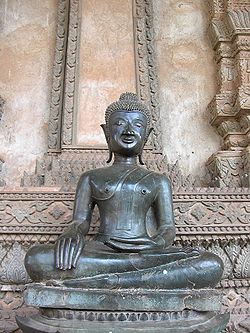
Laos
Laos Lao: ສາທາລະນະລັດ ປະຊາທິປະໄຕ ປະຊາຊົນລາວ Sathalanalat Paxathipatai Paxaxon Lao, officially the Lao People's Democratic Republic, is a landlocked country in Southeast Asia, bordered by Burma and China to the northwest, Vietnam to the east, Cambodia to the south and Thailand to the west...
and Thailand
Thailand
Thailand , officially the Kingdom of Thailand , formerly known as Siam , is a country located at the centre of the Indochina peninsula and Southeast Asia. It is bordered to the north by Burma and Laos, to the east by Laos and Cambodia, to the south by the Gulf of Thailand and Malaysia, and to the...
is referred to as pang phraputtarup :th:ปางพระพุทธรูป, and a given pose as pang . These recall specific episode
Episode
An episode is a part of a dramatic work such as a serial television or radio program. An episode is a part of a sequence of a body of work, akin to a chapter of a book. The term sometimes applies to works based on other forms of mass media as well, as in Star Wars...
s during his travels and teachings that are familiar to the Buddhists according to an iconography
Iconography
Iconography is the branch of art history which studies the identification, description, and the interpretation of the content of images. The word iconography literally means "image writing", and comes from the Greek "image" and "to write". A secondary meaning is the painting of icons in the...
with specific rules; certain ones of these are considered particularly auspicious for those born on particular days of the week.
In other Buddhist countries, different but related iconography is used, for example the mudras in Indian art.
Introduction
The Buddha is always represented a with certain physical attributes, and in specified dress and specified poses. Each pose, and particularly the position and gestures of the Buddha's hands, has a defined meaning which is familiar to Buddhists.For Buddhists, the correct depiction of the Buddha is not an anabolistic matter; Buddhists believe that a properly rendered Buddha image is a hypostasis
Hypostasis (religion)
In Christian theology, a hypostasis or person is one of the three elements of the Holy Trinity.In Christian usage, the Greek word hypostasis means beneath-standing or underpinning and, by extension, the existence of some thing...
: an actual spiritual emanation of the Buddha, which possesses supernatural qualities. Although the Buddha is not a god, Buddhists seek to communicate with the supernatural world through Buddha images, making offerings to them and praying before them.
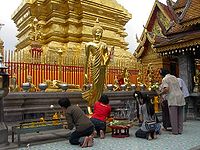
When creating a Buddha image, the artist is expected to be in a spiritual and mental state (samādhi) that will enable him to visualise this ideal reality. There is no requirement that every Buddha image be identical, and in fact there is a wide variety of artistic styles and national traditions in representing the Buddha. There are, however, certain rules of representation that must be adhered to.
The current range of postures in which the Buddha may be shown, and the gestures which may be depicted, evolved over the first millennium of the Buddhist era (roughly 500 BCE to 500 CE), mainly in India
India
India , officially the Republic of India , is a country in South Asia. It is the seventh-largest country by geographical area, the second-most populous country with over 1.2 billion people, and the most populous democracy in the world...
, the original homeland of Buddhism. In the early part of this period, the Buddha was usually shown giving a general gesture of benediction, with the right hand held at shoulder-height with the palm facing forward and the fingers together and slightly bent. By the end of the Gupta Empire
Gupta Empire
The Gupta Empire was an ancient Indian empire which existed approximately from 320 to 550 CE and covered much of the Indian Subcontinent. Founded by Maharaja Sri-Gupta, the dynasty was the model of a classical civilization. The peace and prosperity created under leadership of Guptas enabled the...
(about 550 CE), the canon of representation had become more varied, with the seated meditative position (dhyāna mudrā - see below) becoming common, particularly in Sri Lanka
Sri Lanka
Sri Lanka, officially the Democratic Socialist Republic of Sri Lanka is a country off the southern coast of the Indian subcontinent. Known until 1972 as Ceylon , Sri Lanka is an island surrounded by the Indian Ocean, the Gulf of Mannar and the Palk Strait, and lies in the vicinity of India and the...
. By the 7th century CE the canon was largely as it is seen today.
As Buddhism spread from India to other countries, variations in the depiction of the Buddha evolved. This article describes the canon of Buddha representation in Thailand and Laos. This canon was not formalised until the 19th century, as part of the general project of "modernisation" that followed the Buddhist world's encounter with Western civilisation. A key figure in this process was the Siamese royal prince and Buddhist monk Paramanuchit Chinorot, a son of King Rama I, who in 1814 was appointed administrator of the Wat Pho
Wat Pho
Wat Pho , is a Buddhist temple in Phra Nakhon district, Bangkok, Thailand. It is located in the Rattanakosin district directly adjacent to the Grand Palace. Known also as the Temple of the Reclining Buddha, its official name is Wat Phra Chettuphon Wimon Mangkhalaram Ratchaworamahawihan...
royal temple in Bangkok
Bangkok
Bangkok is the capital and largest urban area city in Thailand. It is known in Thai as Krung Thep Maha Nakhon or simply Krung Thep , meaning "city of angels." The full name of Bangkok is Krung Thep Mahanakhon Amon Rattanakosin Mahintharayutthaya Mahadilok Phop Noppharat Ratchathani Burirom...
. At the request of King Rama III, Paramanuchit described and represented 40 different postures of the Buddha in an illustrated treatise called Pathama Sambodhikatha. Some of these, such as "Buddha threading a needle," were new, although justified through reference to the literary accounts of the Buddha's life. Paramanuchit's illustrations were later rendered as bronze miniatures, which can be seen today at Wat Phra Kaew
Wat Phra Kaew
The Wat Phra Kaew is regarded as the most sacred Buddhist temple in Thailand. It is a "potent religio-political symbol and the palladium of Thai society". It is located in the historic centre of Bangkok , within the precincts of the Grand Palace.The main building is the central ubosoth, which...
in Bangkok and serve as templates for the creation of modern Buddhist imagery.
Attributes of the Buddha
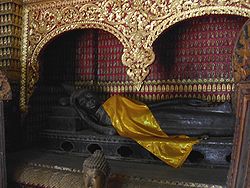
The Dīgha Nikāya
Digha Nikaya
The Digha Nikaya is a Buddhist scripture, the first of the five nikayas, or collections, in the Sutta Pitaka, which is one of the "three baskets" that compose the Pali Tipitaka of Theravada Buddhism...
, a Pāli
Páli
- External links :* *...
text of the 1st century BCE, gives a list of 32 physical attributes of the Buddha. Some of these are poetic or fanciful ("legs like an antelope's," "ankles like rounded shells"), while others are more specific: feet with level tread, projecting heels, long and slender fingers and toes, a tuft of hair between the eyebrows. Although it is not required that Buddha images reflect all of these attributes, many of them have acquired canonical status.
Most curiously, the Buddha is said to have had a protuberance on the top of his skull, the usnīsa. This is sometimes shown as a spire or spike, and sometimes only as a small bump. The Buddha always has a serene expression or a faint smile. The Buddha is also always depicted with very long earlobes
Stretching (body piercing)
Stretching, in the context of body piercing, is the deliberate expansion of a healed fistula for the purpose of wearing body piercing jewelry. Ear piercings are the most commonly stretched piercings, with nasal septum piercings, tongue piercings and lip piercings/lip plates following close behind...
. This is attributed to his earlier life as a prince, weighed down by material possession, but has since come to symbolize wisdom.
Posture and dress

- Sitting: If seated, the Buddha may be shown in one of three different positions
- In the "heroic posture" (vīrāsana), with the legs folded over each other
- In the "adamantine posture" (vajrāsana), with the legs crossed so that the soles of both feet are turned up
- In the position of a person sitting in a chair (pralambanāsana)
- Standing: If standing, the Buddha may be shown either with his feet together, or with one foot forward
- Walking
- Reclining: The reclining posture may represent the Buddha resting or sleeping, but more usually represents the mahāparinabbāna: the Buddha's final state of enlightenment before his death

Hand gestures
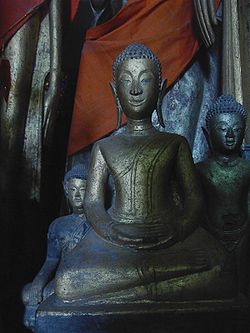
Mudra
A mudrā is a symbolic or ritual gesture in Hinduism and Buddhism. While some mudrās involve the entire body, most are performed with the hands and fingers...
. These gestures have meanings which are known throughout the Buddhist world, and when combined with the postures described above, give a complete representation, usually associated with a particular incident in the life of the Buddha.
The six mudrā associated with the Buddha are:
- Touching the earth (Bhūmiśparṣa mudrā) :th:ปางมารวิชัย pang maa-rá-wí-chai: the right arm rests on the right thigh with the fingers pointing downwards, but not always touching the earth (as can be seen in the image at the top of this page). The left hand rests in the dhyāna mudrā position in the Buddha's lap. This mudrā is called in PāḷiPáli- External links :* *...
and SanskritSanskritSanskrit , is a historical Indo-Aryan language and the primary liturgical language of Hinduism, Jainism and Buddhism.Buddhism: besides Pali, see Buddhist Hybrid Sanskrit Today, it is listed as one of the 22 scheduled languages of India and is an official language of the state of Uttarakhand...
"calling the earth to witness (to his fulfilment of the perfections, pāramī). In Thai it is known as "Buddha subduing MāraMara (demon)In Buddhism, Māra is the demon that tempted Gautama Buddha by trying to seduce him with the vision of beautiful women who, in various legends, are often said to be Mara's daughters. In Buddhist cosmology, Mara personifies unwholesome impulses, unskillfulness, the "death" of the spiritual life...
" (the demon who tried to prevent him attaining enlightenment by various means). This is by far the most commonly depicted mudrā. - Meditation (Dhyāna mudrā) :th:ปางสมาธิ pang sà-măa-tí: the hands are shown lying flat in the Buddha's lap, palms upward. This mudrā is associated with a seated Buddha. It shows that the Buddha is disciplining his mind through mental concentration, a necessary step to achieving enlightenment.
- Charity (Varana mudrā) :th:ปางประทานพร pang bprà-taan pon: the right arm is shown pendent (extended downwards), with the open palm turned to the front and the fingers extended. This mudrā is usually associated with a standing Buddha. This position can signify either that the Buddha is granting blessings or receiving charitable offerings.
- Fearlessness (Abhāya mudrā) :th:ปางประทานอภัย pang bprà-taan à-pai: either one or both arms are shown bent at the elbow and the wrist, with the palm facing outwards and the fingers pointing upwards. It shows the Buddha either displaying fearlessness in the face of adversity, or enjoining others to do so. Right hand raised is also called "calming animals" :th:ปางโปรดสัตว์ pang pròht sàt; both hands raised is also called "forbidding the relatives" :th:ปางห้ามญาติ pang ham yat. These mudrā are usually associated with a standing Buddha, but seated representations are not uncommon.
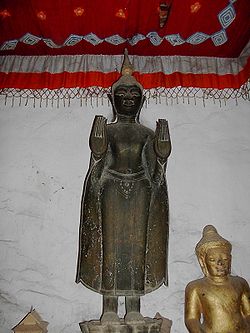
- Reasoning and exposition (Vitarka mudrā): the arm and hand are positioned in the same manner as in the abhāya mudrā, except that the thumb and forefinger are brought together. The gesture can be made with either the right or left hand (usually the right), but not both. This mudra signifies an appeal to reason, or the giving of instruction. Since the Buddha is appealing to reason, the gesture is often interpreted as an appeal for peace.
- Setting the wheel in motion (Dharmachakrā mudrā): the hands are held in front of the chest, with both hands in the vitarka mudrā position, with the fingers of the left hand resting in the palm of the right hand. This is a less common mudrā since it refers to a particular episode in the Buddha's life: his first sermon, when he "set the wheel (of his life's work) in motion." It can be used for both seated and standing images.
Over the centuries combinations and variations of these six mudrā have evolved. For example the "double abhāya mudrā", with both hands held up in the abhāya mudrā position, became common in Thailand and Laos in the 16th century, and is now one of the most common representations of the Buddha in south-east Asian countries. It is sometimes interpreted as "Buddha teaching on reason." As artists wished to depict more of the specific incidents in the life of the Buddha, new, secondary mudrās evolved, such as "Buddha holding an alms bowl", "Buddha receiving a mango" and Buddha performing various miracles. Many of these originated in Burma and then spread to other parts of the Buddhist world.
See also
- BudaiBudăiBudăi may refer to places in Romania:* Budăi, a village administered by Podu Iloaiei town, Iaşi County* Budăi, hill in the proximity of Călugăreni in Botoşani Countyand to several in Moldova:* Budăi, Taraclia, a commune in Taraclia district...
and its entry for Phra Sangkadchai/Phra Sangkachai, pot-bellied figures sometimes confused with the Buddha, as well as with each other - Buddha images in ThailandBuddha images in ThailandA Buddha image in Thailand typically refers to three dimensional stone, wood, clay, or metal cast images of the Buddha. While there are such figures in all regions where Buddhism is commonly practiced, the appearance, composition and position of the images vary greatly from country to...
(provides historical perspective) - Lao Buddhist sculptureLao Buddhist sculpture-Overview:Lao artisans have, throughout the past, used a variety of media in their sculptural creations. Of the metals, bronze is probably the most common, but gold and silver images also exist...
Sources
- Gestures of the Buddha, K.I.Matics, Chulalongkorn University Press, Bangkok 2004
- Untitled booklet, Khochone Keomanivong et al., Ho Phra Kaeo Museum, Viang Chan, Laos (undated)

